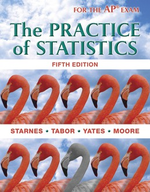Solution Found!
Returns on common stocks The return on a stock is the change in its market price plus
Chapter 1, Problem 51(choose chapter or problem)
The return on a stock is the change in its market price plus any dividend payments made. Total return is usually expressed as a percent of the beginning price. The figure below shows a histogram of the distribution of the monthly returns for all common stocks listed on U.S. markets over a 273-month period. The extreme low outlier represents the market crash of October 1987, when stocks lost 23% of their value in one month.
(a) Describe the overall shape of the distribution of monthly returns.
(b) What is the approximate center of this distribution?
(c) Approximately what were the smallest and largest monthly returns, leaving out the outliers?
(d) A return less than zero means that stocks lost value in that month. About what percent of all months had returns less than zero?
Questions & Answers
QUESTION:
The return on a stock is the change in its market price plus any dividend payments made. Total return is usually expressed as a percent of the beginning price. The figure below shows a histogram of the distribution of the monthly returns for all common stocks listed on U.S. markets over a 273-month period. The extreme low outlier represents the market crash of October 1987, when stocks lost 23% of their value in one month.
(a) Describe the overall shape of the distribution of monthly returns.
(b) What is the approximate center of this distribution?
(c) Approximately what were the smallest and largest monthly returns, leaving out the outliers?
(d) A return less than zero means that stocks lost value in that month. About what percent of all months had returns less than zero?
ANSWER:Step 1 of 5
Given histogram is
Here the total return is shown as the percent of the beginning price.
